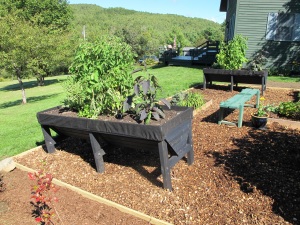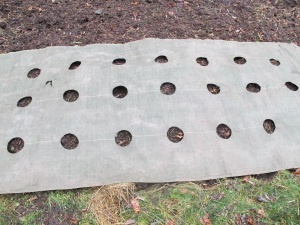Holiday Gifts for the Gardener
It’s that time of year again: time to find the perfect present for Aunt Edna, Uncle Bob and everyone else we love. Gardeners on my list are pretty easy to buy for because there are so many wonderful gifts to choose from, including selections under $10 (Atlas nitrile gardening gloves, packets of my favorite seeds) to expensive coffee table books and wheelbarrows that cost $300 or more. Let me offer a few suggestions.
Let’s start at the high end. One of my coaching clients this summer wanted some raised beds that were actually tall enough so that she wouldn’t have to bend over. She ordered some ‘VegTrugs’ from Gardener’s Supply (www.gardeners.com or 802-660-3500). These are wood growing containers made of fir that are about 6 feet long, 30 inches wide and 32 inches tall – about the same height as your kitchen table.
The VegTrug is V-shaped in cross-section and lined with a fabric that keeps soil from washing through between the slats. This container is deep and hold 380 quarts of soil mix – about 10 bags. We filled it with a 50-50 mix of compost and topsoil bought in bulk, and added some perlite and peat moss to keep the soil fluffy. It performed very well, growing tomatoes and eggplants in the middle, and shallow rooted things like lettuce and basil along the edges. At $249, it’s an investment, but well designed and it should last for years. Gardener’s Supply has a number of other kinds of raised beds. My client assembled her VegTrug in about an hour, and some of the others are even simpler.
Weeding is the least fun part of gardening for many, and anything that helps to reduce weed numbers is a good gift. A few years ago I got some rolls of weed mat that came with pre-punched holes spaced appropriately for growing tomatoes, or lettuce – or you name it. This is a woven polypropylene mat that the maker claims will last 10 years.
The mats come in 4-foot wide strips with evenly spaced holes in 8 different sizes and spacings. They block out light, keeping weeds from growing, while also moderating temperature and water loss. From 10.99 for a 6-foot piece to $30.99 for an 18-foot length. Made in Vermont, available from www.GardenMats.com or by calling 802-498-3314.
Each year I remind readers that in my opinion the best weeding tool made is the CobraHead weeder (www.CobraHead.com or 866-962-6272). This is a single steel finger, curved and sharp, that will get under weeds and lift them out, tease out grass roots or prepare the soil for planting. It is $24.95, including shipping. Made in America, too.
Watering well is important in dry times. Plants need gentle streams of water that can best be delivered by a watering wand. These devices have long metal handles with a rose (water sprayer) on the end. The best wands are made by Dramm, but many knock-offs are sold, too. Go for the best. Why? They have figured out how to aerate the water so that lots of water can come out, fast, but gently. My wand allows me to walk along and get water where I want it: on the ground, near the plants, but not on the foliage. Available at good garden centers everywhere. About $20.
Books are loved by gardeners. Designing flower gardens? An excellent book is by Julie Moir Messervy, Landscaping Ideas that Work (Taunton Press, $21.95). This is a good overview and introduction to the basics of landscape design, starting with a checklist of the atmosphere, activities and features you would like. It is simple and straightforward with lots of color pictures. Granted, the pictures are mostly of expensive houses and projects, but she gives readers an idea of relative cost of various options (brick walkways, or stone, or packed earth) by using 1 to 4 dollar signs next to each.
The New Vegetable Growers Handbook: A users manual for the organic vegetable garden by Frank Tozer (distributed by Chelsea Green Publishing, $27.95) is an excellent reference text for anyone who grows veggies. It has detailed growing information on nearly 100 different veggies and has great tips on practical matters such as how to avoid getting bitter-tasting cucumbers or how day length affects the size of your onions, and why you should plant them early in spring. Want to try new greens? Tozer tells you how to grow Komatsuna and Mizuna and Mibuna and more. By the way, Chelsea Green Publishing (www.chelseagreen.com) has lots of other good gardening and permaculture books worth looking at.
Record keeping is important if you want to improve your gardening skills and to learn from past years. The Moleskine Company (www.moleskine.com) makes many journals, including a gardening journal that offers 240 pages, including space to record your efforts and useful information such as hardiness zones. It has design grids for planning and adhesive labels for personalizing sections. It’s $19.95 and found at many bookstores.
Santa Claus, if you’re listening, what I really want this year is another load of manure. Just have your reindeer drop a load of black garden gold anywhere near my vegetable garden. A pick-up truck load would be great or, if you think I’ve been a very good boy a dump-truck load!
Henry Homeyer has his own gardening books, signed, available from his web site, www.Gardening-Guy.com.




